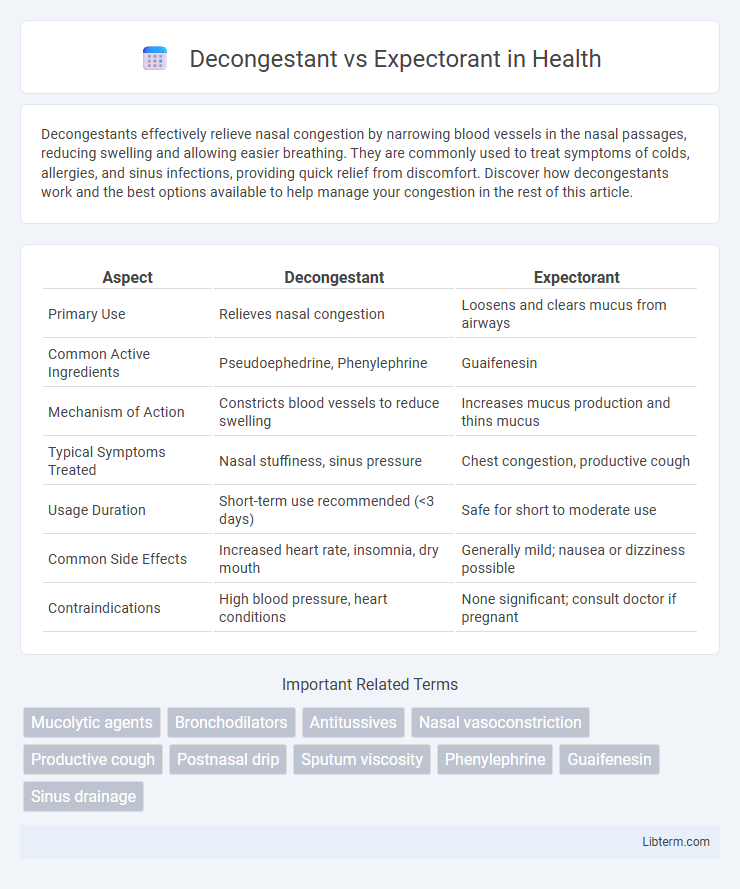Decongestants effectively relieve nasal congestion by narrowing blood vessels in the nasal passages, reducing swelling and allowing easier breathing. They are commonly used to treat symptoms of colds, allergies, and sinus infections, providing quick relief from discomfort. Discover how decongestants work and the best options available to help manage your congestion in the rest of this article.
Table of Comparison
| Aspect | Decongestant | Expectorant |
|---|---|---|
| Primary Use | Relieves nasal congestion | Loosens and clears mucus from airways |
| Common Active Ingredients | Pseudoephedrine, Phenylephrine | Guaifenesin |
| Mechanism of Action | Constricts blood vessels to reduce swelling | Increases mucus production and thins mucus |
| Typical Symptoms Treated | Nasal stuffiness, sinus pressure | Chest congestion, productive cough |
| Usage Duration | Short-term use recommended (<3 days) | Safe for short to moderate use |
| Common Side Effects | Increased heart rate, insomnia, dry mouth | Generally mild; nausea or dizziness possible |
| Contraindications | High blood pressure, heart conditions | None significant; consult doctor if pregnant |
Introduction to Decongestants and Expectorants
Decongestants reduce nasal swelling by constricting blood vessels in the respiratory tract, effectively relieving congestion and improving airflow. Expectorants work by thinning mucus in the airways, promoting easier coughing and clearing of mucus from the lungs. Both medications target respiratory symptoms but address different underlying causes of congestion and mucus buildup.
What Are Decongestants?
Decongestants are medications designed to relieve nasal and sinus congestion by narrowing blood vessels in the nasal passages, reducing swelling and allowing easier airflow. Common active ingredients in decongestants include pseudoephedrine and phenylephrine, which are available in oral and nasal spray forms. These drugs are primarily used to treat symptoms of colds, allergies, and sinus infections, but should be used cautiously as they can raise blood pressure and cause insomnia.
How Decongestants Work
Decongestants work by narrowing the blood vessels in the nasal passages, reducing swelling and congestion to improve airflow. These medications primarily target alpha-adrenergic receptors, leading to vasoconstriction and diminished nasal tissue inflammation. Common decongestants include pseudoephedrine and phenylephrine, which provide rapid relief from sinus pressure and nasal blockage.
Common Types of Decongestants
Common types of decongestants include pseudoephedrine, phenylephrine, and oxymetazoline, which effectively reduce nasal swelling and ease breathing by constricting blood vessels. Pseudoephedrine is often found in oral medications, while oxymetazoline is typically used as a nasal spray for rapid relief. These decongestants target nasal congestion, providing contrast to expectorants, which help loosen mucus in the airways.
What Are Expectorants?
Expectorants are medications designed to thin and loosen mucus in the airways, making it easier to cough up and clear congestion from the respiratory tract. Common expectorants like guaifenesin increase the hydration of mucus, improving airflow and reducing chest congestion associated with colds, bronchitis, and other respiratory conditions. Unlike decongestants, which primarily reduce nasal swelling and congestion, expectorants target mucus consistency to facilitate productive coughing.
How Expectorants Work
Expectorants work by thinning and loosening mucus in the airways, making it easier to cough up and clear congestion from the respiratory tract. Common active ingredients like guaifenesin increase the hydration of mucus, reducing its viscosity and facilitating better airflow. This mechanism contrasts with decongestants, which primarily constrict blood vessels to reduce nasal swelling and congestion without directly affecting mucus consistency.
Common Types of Expectorants
Common types of expectorants include guaifenesin, which helps thin and loosen mucus in the airways, making it easier to cough up and clear congestion. Potassium iodide and ammonium chloride are less commonly used expectorants that also aid in mucus clearance by increasing bronchial secretions. These medications are primarily used to treat productive coughs associated with colds, bronchitis, and other respiratory conditions.
When to Use Decongestants vs Expectorants
Decongestants are best used for relieving nasal congestion caused by colds, allergies, or sinus infections by narrowing blood vessels in the nasal passages to reduce swelling and mucus build-up. Expectorants are effective when dealing with chest congestion, as they loosen and thin mucus, making it easier to cough up and clear the airways. Choosing between decongestants and expectorants depends on whether the primary symptom is nasal blockage or chest congestion to ensure targeted symptom relief.
Side Effects and Precautions
Decongestants commonly cause side effects such as increased blood pressure, insomnia, and nervousness, requiring caution in patients with hypertension or cardiovascular conditions. Expectorants may lead to gastrointestinal discomfort, including nausea and vomiting, with precautions necessary for individuals with chronic cough due to underlying conditions. Both medications should be used according to dosing guidelines to minimize adverse effects and avoid drug interactions.
Choosing the Right Treatment for Your Symptoms
Decongestants relieve nasal swelling by constricting blood vessels, effectively reducing sinus pressure and improving airflow. Expectorants thin mucus, making it easier to cough up and clear chest congestion. Selecting the right treatment depends on whether nasal congestion or chest mucus buildup is the primary symptom to ensure effective symptom relief.
Decongestant Infographic

 libterm.com
libterm.com